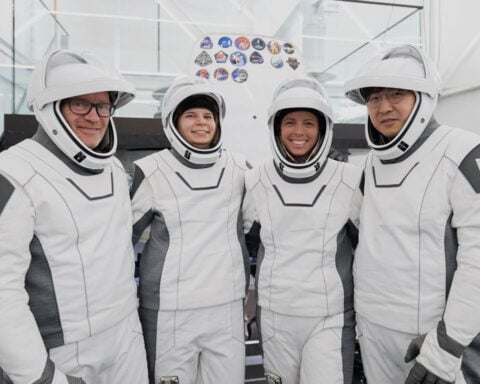(CNN) — For 66-year-old Tim Andrews, it was a matter of life or death.
Andrews had spent the better part of two years on dialysis because of end-stage kidney disease. He was on the transplant wait list for a new kidney, but his blood type made it particularly difficult to find a donor organ.
The average wait time for a kidney is three to five years at most centers, but studies have found that people with type-O blood can wait as long as 10 years to receive a kidney. His chances of living five more years on long-term dialysis are just around 35%. His doctors estimated that he had about a 9% chance of getting an organ in the next five years.
Andrews said he had a “shortage of time.”
“It really becomes very, very depressing that this is it, you know? ” he recalls thinking. “This is how I’m going to end my life. I’m going to be going to dialysis and being tired.”
So Andrews didn’t hesitate when his doctors at Massachusetts General Hospital asked whether he would consider an experimental transplant using a kidney from a donor pig.
“All of a sudden, I’m not in the darkness. I’m going to get better. I am going to do this,” Andrews said in a hospital interview shared with journalists.
On Friday, doctors at Massachusetts General Hospital announced that Andrews had successfully received the pig kidney. The January 25 procedure took place through the US Food and Drug Administration’s Expanded Access pathway, often known as compassionate use, which allows patients with life-threatening conditions to access investigational medical products. He’ll be the first in a three-patient study and is the second person currently living in the world with a pig kidney.
The team at Massachusetts General used an organ developed by Cambridge, Massachusetts-based biotech company eGenesis.
“Our three-patient study this year will provide critical insights into the long-term viability of xenotransplants as a transformative solution for thousands of patients in need of a life-saving kidney,” Dr. Leonardo Riella, medical director for kidney transplantation at Massachusetts General Hospital, said in a statement.
‘One of the many holy grails’
The practice of transplanting animal organs into humans, known as xenotransplantation, has long felt like science fiction. However, in the past three years, half a dozen such procedures have taken place in the United States using pigs that have been genetically modified, so their organs are more compatible with humans’.
Using the gene-editing technique CRISPR, scientists can modify the pig’s DNA. eGenesis workers make more than 60 edits to help manage a host of potential issues including rejection, size of the organ and even pig retroviruses that could potentially infect humans.
Another biotech company, United Therapeutics, announced this week that it had received the green light from the FDA to move forward with a xenotransplant trial with its pig kidneys, which have 10 gene edits. The company expects to perform the first of six initial transplants in people with end-stage kidney disease in the middle of 2025, with the intent of expanding the trial to a total of 50 patients.
United Therapeutics expects pig kidney transplants to be an established option for patients by the end of this decade, spokesperson Dewey Steadman said.
For those in the transplant field, the approval of clinical trials is a major turning point.
“The whole field has been working towards this moment of clarity and the ability to go into patients,” said Mike Curtis, CEO of eGenesis. “It creates a very clear path for us to bring this technology to more patients.”
Early in her decades-long career, Dr. Jayme Locke said she wasn’t sure she would see this technology make its way to the operating table.
“This is one of the many holy grails, I think, that we’ve been trying to achieve in the field of transplantation,” said Locke, a transplant surgeon at NYU Langone Health who was not involved in Andrews’ case.
Locke sees it as a benefit to have multiple companies with different genetic models enter trials. “We have yet to define what the optimal genetic edits are going to be,” she said. And it’s likely that different people will respond differently to the genetic edits, with some matching better with one than the other.
A true test of the potential
Until recently, attempts at xenotransplant with pig kidneys resulted in about two more months of life for the patients. However, Locke said those cases aren’t a true test of xenotransplant’s potential.
Earlier attempts at transplanting pig kidneys into humans, including one last year at Mass General, were done in people who had such significant health issues that they didn’t qualify to be on the organ wait list.
“Being able to do this in an individual who is robust and otherwise qualified for wait-listing is really, I think, helpful,” Locke said.
Locke has been involved in the transplant and care of 53-year-old Towana Looney, who received a pig kidney from United Therapeutics in November at NYU Langone’s Transplant Institute. Looney, an Alabama native, has been living in New York since then, receiving constant monitoring and follow-up. Now at 74 days post-transplant, Looney holds the record for the longest-living recipient of a pig organ and is the best proof yet that pig organs could be a viable source for donor organs.
“Once we’re past that 90-day mark, we can actually say that the xenograft has helped a patient achieve a similar survival benefit as what we have seen in human transplant,” Locke said.
She speaks with Looney almost daily and said her patient is “living her best life.”
“From the moment I saw that kidney start to make urine in the operating room that day to seeing her that evening after surgery, and she already had this vibrant, I mean, her cheeks had a rose color to them. She was more alive. Her family could see it,” Locke said. “The joy and the hope that was restored was just tremendous.”
Hope for thousands of patients
“As soon as I woke up after the surgery, the cloud of dialysis disappeared,” Andrews said in a statement from eGenesis. “I felt re-energized and revitalized. It was a miracle. The magnitude of what these doctors and nurses accomplished is unbelievable and I want to thank them for giving me a new lease on life.”
Andrews was discharged just one week after the transplant but is continuously monitored, returning to the clinic three times a week for blood tests. In addition, he has multiple devices that allow the clinical team to check his vitals and heart rhythm remotely. As with a human donor kidney, he’ll need to take medications for the rest of his life to keep his body from rejecting the organ.
“But this transplant isn’t about me,” he said. “It’s about all the people who I met at the dialysis clinic, and I saw what they were going through.”
In the US, 37 million adults have chronic kidney disease, and about 800,000 of them have end-stage kidney failure.
“We have wait-listed typically, in any given year, between 80,000 and 100,000 [patients], and we perform about 25,000 to 28,000 kidney transplants a year,” Locke said. “So when you start backing it up, you realize the magnitude of what this offers, right? Because not everybody who has kidney failure can even make it to the waiting lists.”
For patients like Andrews, this new organ holds a promise he never anticipated: “It’s a glimmer of hope,” he said.
The-CNN-Wire
™ & © 2025 Cable News Network, Inc., a Warner Bros. Discovery Company. All rights reserved.

 Trump has begun another trade war. Here's a timeline of how we got here
Trump has begun another trade war. Here's a timeline of how we got here
 Canada's leader laments lost friendship with US in town that sheltered stranded Americans after 9/11
Canada's leader laments lost friendship with US in town that sheltered stranded Americans after 9/11
 Chinese EV giant BYD's fourth-quarter profit leaps 73%
Chinese EV giant BYD's fourth-quarter profit leaps 73%
 You're an American in another land? Prepare to talk about the why and how of Trump 2.0
You're an American in another land? Prepare to talk about the why and how of Trump 2.0
 Chalk talk: Star power, top teams and No. 5 seeds headline the women's March Madness Sweet 16
Chalk talk: Star power, top teams and No. 5 seeds headline the women's March Madness Sweet 16
 Purdue returns to Sweet 16 with 76-62 win over McNeese in March Madness
Purdue returns to Sweet 16 with 76-62 win over McNeese in March Madness







